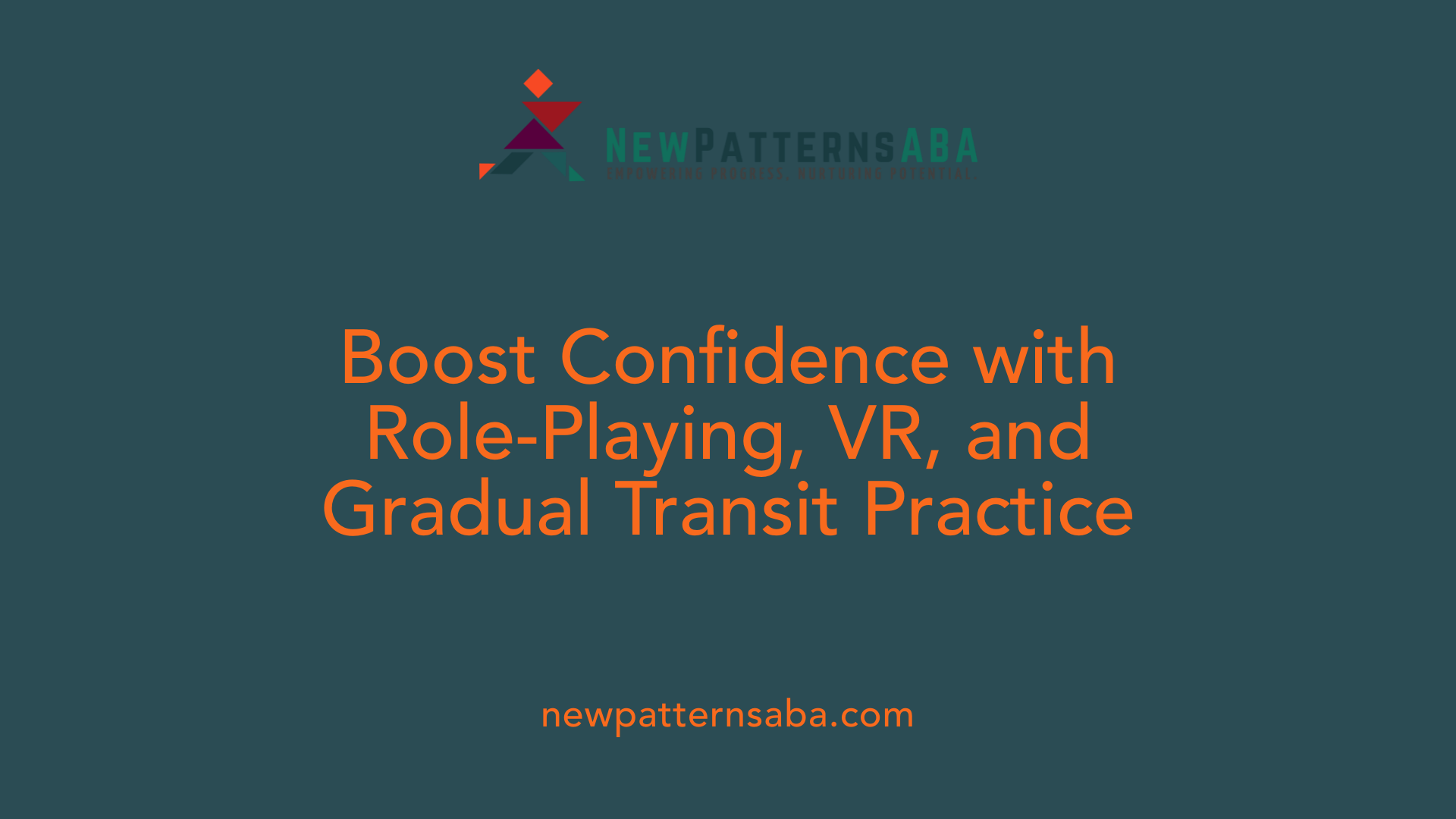Empowering Autistic Teens for Community Mobility
Facilitating Independence in Public Transit for Teens with Autism
Teaching public transportation skills to autistic teens is essential in promoting independence, community participation, and safety. This comprehensive approach combines personalized support, sensory accommodations, and innovative training methods to prepare adolescents for navigating buses, trains, and other transit modes confidently and safely.
Personalized Social Stories and Visual Supports
 Creating tailored social stories and visual aids is an effective way to help children with autism understand bus routines and expectations. These stories can be customized to suit each child's specific needs, highlighting familiar situations and appropriate responses to reduce anxiety.
Creating tailored social stories and visual aids is an effective way to help children with autism understand bus routines and expectations. These stories can be customized to suit each child's specific needs, highlighting familiar situations and appropriate responses to reduce anxiety.
Using pictorial or written step-by-step guides is also beneficial for managing transit routines and unexpected events. For example, visual aids can depict the process of checking bus schedules, walking to the bus stop, boarding and exiting the bus, paying fares, and offering seats. These guides serve as clear reminders that children with autism can refer to, helping them feel more confident and reducing stress during travel.
Visual supports such as schedule checklists, instructions for fare payment, and cues for staying safe are crucial in enhancing understanding. Implementing these tools during training sessions can help children learn routines at their own pace, making travel less overwhelming.
By incorporating these strategies, transportation experiences become more predictable and less stressful, fostering independence in autistic teens. Additionally, these supports are aligned with best practices for teaching public transportation skills, emphasizing the importance of clear, visual communication tailored to the child's developmental level and preferences.
Sensory Support Strategies for Transit Experiences
What accommodations and support methods can facilitate independent transportation for autistic adolescents?
Supporting autistic teens in using buses and other transit options independently involves several tailored strategies. Sensory supports—such as noise-cancelling headphones, ear defenders, and fidget toys—help manage sensitivities to loud noises and unexpected stimuli. Implementing consistent routines, like fixed pick-up and drop-off times, also reduces anxiety associated with unpredictability.
How can caregivers and educators prepare autistic teens to use school buses and public transit independently?
Preparation focuses on creating familiarity and comfort with transit routines. Visual aids, like pictorial or written step-by-step guides, help teens understand each phase of the journey—checking schedules, walking to stops, boarding, paying fares, and sitting comfortably. Including these during training reduces stress and builds confidence.
Managing sensory overload during transit
To further ease sensory challenges, children and teens often wear noise-cancelling headphones or listen to calming music. Carrying familiar objects with recognizable scents or textures—such as favorite toys, scented handkerchiefs, or fabric pieces—provides a sense of security.
Implementation of sensory-friendly modifications
Buses can be adapted to be more sensory-friendly. This includes climate-controlled environments and, where possible, the use of sensory rooms during transit preparation. These modifications create a more comfortable travel experience and help prevent sensory overload.
Here’s a quick overview of support tools and accommodations:
| Support Tool/Strategy | Description | Purpose |
|---|---|---|
| Noise-cancelling headphones | Reduce auditory input | Minimize noise-related stress |
| Fidget toys | Engage hands and distract | Alleviate anxiety |
| Soothing music | Relaxation aid | Decrease sensory overload |
| Familiar objects with scents/textures | Comfort during travel | Reduce sensory anxiety |
| Climate-controlled buses | Maintain comfortable temperature | Avoid sensory discomfort |
| Visual step-by-step guides | Clear routines illustration | Reduce confusion and stress |
Using these supports and accommodations, children and teens with autism can navigate their transportation routines more independently, safely, and comfortably.
Building Confidence Through Role-Playing and Gradual Exposure
 To support autistic teens in gaining independence with public transportation, incorporating simulated transit practice through role-playing and virtual reality (VR) environments can be extremely effective. These techniques allow teens to familiarize themselves with transit routines in a controlled, safe setting, reducing anxiety and increasing confidence.
To support autistic teens in gaining independence with public transportation, incorporating simulated transit practice through role-playing and virtual reality (VR) environments can be extremely effective. These techniques allow teens to familiarize themselves with transit routines in a controlled, safe setting, reducing anxiety and increasing confidence.
Role-playing activities can include practicing trusting interactions with bus drivers and staff, following step-by-step routines like paying fares or signaling stops, and handling unexpected scenarios such as delays or route changes. When paired with VR, teens can experience immersive transit environments without leaving a classroom or therapy space. VR simulations recreate bus rides, station navigation, and other transit experiences, providing realistic practice that prepares teens for real-world travel.
Gradual exposure is another crucial strategy. This involves starting with brief, familiar trips and gradually increasing the distance and complexity of transit routines. Trial runs with familiar staff or family members further facilitate this process. Regular exposure helps reduce sensory challenges and behavioral anxieties.
Collaboration with behavioral professionals plays a vital role during this preparation. Specialists can reinforce positive behaviors, develop tailored routines, and offer strategies to manage sensory overload and behavioral challenges. These professionals often incorporate visual supports, social stories, and technology-based interventions.
Research shows that these approaches significantly improve independence and comfort in using public transportation for autistic teens. For example, innovative methods like virtual reality provide a safe, engaging way to master transit skills, which is especially valuable given the potential stressors of real-world travel.
| Method | Description | Benefits |
|---|---|---|
| Role-Playing | Acting out transit scenarios | Builds social skills and routine familiarity |
| Virtual Reality | Immersive transit environment simulations | Enhances learning, reduces real-world anxiety |
| Gradual Exposure | Incremental trips and route practice | Increases confidence and reduces overwhelm |
| Professional Support | Behavior specialists and trained staff | Reinforces positive behaviors and routines |
These combined strategies can pave the way for smoother, more confident use of public transportation, fostering independence and greater participation in daily activities.
Communication Strategies and Collaboration with Transit Staff

How can communication tools like 'All about Me' packets and the 'My School Bus Ride' form help?
Using detailed visual aids such as 'All about Me' packets allows parents and caregivers to share crucial information about a child's needs, preferences, and sensory sensitivities with bus staff. The 'My School Bus Ride' form can outline specific routines, behavioral expectations, and strategies to manage challenges.
These tools bridge understanding between families and transportation personnel, ensuring that children with autism feel safe and supported during transit. They also assist staff in recognizing signs of distress or overload, enabling immediate and appropriate responses.
Building relationships with bus drivers, aides, and transportation personnel for tailored support
Establishing a positive relationship between families and bus staff is vital. Communication opens lines for sharing updates, concerns, and successes, which helps to customize support and accommodations.
Transportation staff can learn to recognize individual cues and preferences, like preferred seating or sensory tools, based on shared information. This partnership helps in reducing anxiety and behavioral issues, creating a smoother travel experience.
Training staff in autism awareness and responsive support techniques
Providing training for bus drivers and aides on autism awareness is essential. Understanding sensory sensitivities, communication styles, and common behavioral challenges equips staff with responsive techniques.
Training can include the use of visual aids and scenario-based approaches, so staff feel confident managing responses to unexpected events or sensory overloads. Continuous education improves overall safety and comfort for children with autism.
Effective strategies for teaching public transportation skills to autistic teens
A comprehensive approach involves reinforcing routines with visual guides that depict steps like checking schedules, walking to stops, boarding and exiting vehicles, and paying fares. These visual cues can feature simple images or written instructions.
Implementing these visual aids helps teens manage their routines independently and reduces stress during travel. Building strong communication and relationships with transit staff—using tools like 'All about Me' packets—ensures that staff are informed and responsive to each teen's needs.
| Strategy | Purpose | Additional Details |
|---|---|---|
| Use of visual aids | Clarify routines and expectations | Includes pictorial step-by-step guides for boarding, paying, and finding seats |
| Personalized communication tools | Share specific needs effectively | 'All about Me' packets and 'My School Bus Ride' forms |
| Relationship building | Foster trust and responsiveness | Regular interactions with drivers and aides |
| Staff training | Enhance staff responsiveness | Autism awareness and sensory management techniques |
By combining visual supports and collaborative relationships, transportation experiences can be made more manageable and less stressful for autistic teens.
Supporting Behavioral and Social Challenges on Transit
 Addressing bullying and behavioral issues on buses is crucial for creating a safe and supportive environment for autistic teens. Effective communication with school staff helps identify challenges early and develop tailored behavior plans. These plans often include strategies for managing conflict and promoting positive interactions.
Addressing bullying and behavioral issues on buses is crucial for creating a safe and supportive environment for autistic teens. Effective communication with school staff helps identify challenges early and develop tailored behavior plans. These plans often include strategies for managing conflict and promoting positive interactions.
Training process should incorporate social skills instruction specific to public transportation. For example, teaching appropriate ways to ask for space, express discomfort, or get help can reduce misunderstandings.
Using positive reinforcement encourages good behavior. Praising respectful interactions or successfully following routine steps reinforces desired conduct. Behavior management strategies should be consistent, clear, and personalized.
In addition to a structured approach, visual aids like pictorial or written guides can outline steps such as checking schedules, getting on and off the bus, and paying fares. These tools help reduce anxiety and increase independence.
Overall, a combination of proactive planning, social skills training, and positive reinforcement creates a more comfortable transit experience for autistic teens, supporting their social and behavioral growth.
Supporting Successful Transition to Community Mobility

How can caregivers and educators prepare autistic teens to use school buses and public transit independently?
Preparing autistic teens for independent travel involves early discussions about transportation options. By engaging in conversations about driving choices and planning ahead, teens gain a clearer understanding of their options and can develop confidence in using buses and public transit.
Implementing visual aids such as pictorial step-by-step guides helps teens navigate routines like checking schedules, walking to stops, boarding, paying fares, and finding seats. These visual tools provide concrete reminders and reduce anxiety associated with new travel situations.
Training programs that incorporate community and peer support can also be beneficial. These programs teach essential skills, like understanding bus routines, managing unexpected events, and recognizing behavioral expectations.
To further support independence, schools and families can use structured routines and predictable schedules. This consistency helps teens become familiar with their transit routines, decreasing stress and encouraging autonomous travel.
Additionally, personalized stories about bus routines and expectations, as well as visual aids like 'All about Me' packets for bus staff, ensure that accommodations are tailored to each child's needs. Strategies like using noise-cancelling headphones or comfort objects help manage sensory overload during travel.
Overall, fostering independence in community mobility involves comprehensive planning, visual supports, peer training, and sensory accommodations, creating a smoother transition for autistic teens into independent travel.
Fostering Community Integration and Independence in Transit
By combining personalized supports, sensory accommodations, innovative training tools, and collaborative communication, caregivers and educators can greatly enhance the ability of autistic teens to navigate public transportation confidently. Empowering these adolescents not only promotes independence but also enables active participation in community life, education, and social engagement, paving the way for a more inclusive society.
References
- Helping children with autism get ready for the school bus
- Teaching Individuals with ASD to Take Public Transport
- Helping children with autism get ready for the school bus
- 7 Tips for a Great Autism School Bus Ride
- Autism travels
- Travel Tips Tool Kit
- Travel Toolkit | Duke Center for Autism and Brain Development
- 10 Autism travel tips
- Effectiveness of a peer-mediated travel training ...
- Helping children with autism get ready for the school bus






